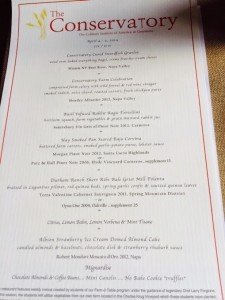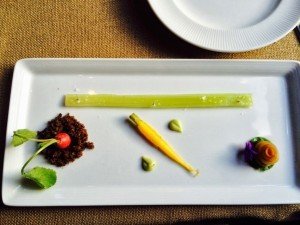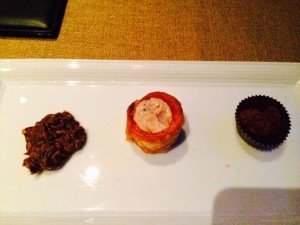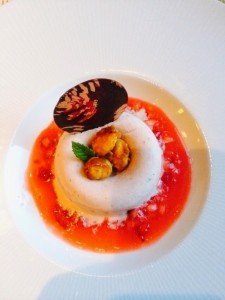The Art of Portion Control
 Good portion control doesn't have to mean deprivation.This may not seem like an earth-shattering point, but so many people I talk to think of portion control as deprivation. That's not it at all! You can control your portions and still feel satisfied -- and it's easier than you think.Recently, I ate an eight-course meal without ever feeling overstuffed. How? Well, I was at the Culinary Institute of America's campus in Napa, where they have a restaurant called the Conservatory. At the Conservatory, I enjoyed beautiful and elegant dishes that were perfectly portioned. From that delicious meal, I distilled 3 tips that people can use to present food in an attractive way -- without loading down their plates.Portion Control Approach #1: The Tiny Terrarium You can build a tiny terrarium that features small and vegetarian treats. A tiny radish, a sliced roasted carrot, toasted pureed chickpeas, compressed farm celery, wild fennel, and a spoon of swiped herb mayonnaise came together to perfectly compose this dish. It reminded me of a terrarium, and each tiny piece was absolutely wonderful.
Good portion control doesn't have to mean deprivation.This may not seem like an earth-shattering point, but so many people I talk to think of portion control as deprivation. That's not it at all! You can control your portions and still feel satisfied -- and it's easier than you think.Recently, I ate an eight-course meal without ever feeling overstuffed. How? Well, I was at the Culinary Institute of America's campus in Napa, where they have a restaurant called the Conservatory. At the Conservatory, I enjoyed beautiful and elegant dishes that were perfectly portioned. From that delicious meal, I distilled 3 tips that people can use to present food in an attractive way -- without loading down their plates.Portion Control Approach #1: The Tiny Terrarium You can build a tiny terrarium that features small and vegetarian treats. A tiny radish, a sliced roasted carrot, toasted pureed chickpeas, compressed farm celery, wild fennel, and a spoon of swiped herb mayonnaise came together to perfectly compose this dish. It reminded me of a terrarium, and each tiny piece was absolutely wonderful.

Portion Control Approach #2: Docked by the SeaYour protein doesn't have to take up the entire plate in order to be filling. Start with a 2-ounce piece of lean protein, then build a border of mashed potatoes and swirl some sauce between the fish and potatoes, as pictured below. The plate looks full, gorgeous, and balanced, yet there's definitely not too much food on it.For a similar effect, you could also make a small ring out of rice or pasta instead of potatoes. Either one would still be able to hold the sauce in place. Consider arranging the piece of protein on a bed of veggies or greens too. The plate below features shaved veggies, delicately flavored and snugged beneath their protein. On this plate, flavor is large, but portions are small.

Portion Control Approach #3: The TrioIt's hard to avoid overdoing it on dessert. You don't want to offer huge portions, but how do you serve a small amount without feeling stingy? The answer lies in good presentation. When it comes to dessert, 3 small bites can be far more attractive than a large hunk of cake, especially when each bite is artfully arranged. Fruit can add a bright pop of color to any plate, and fruit treats are much lower in calories than cream-based desserts. Try making a fresh fruit salsa and a compote of cooked fruit. These two elements can be served individually, or paired with a bit of ice cream, a chocolate-dipped strawberry, or a piece of candy. Seek out complementary flavors and see what options work well together. By nestling a bite of ice cream in a swirl of compote, topped with a chunky fruit salsa, you can keep portions small while still presenting a gorgeous and flavorful dish.In the dessert I had at the Conservatory, a small serving (less than 2 ounces) of ice cream was molded in a ring and topped with crunchy toasted nuts. The drizzle of strawberry rhubarb compote added both flavor and color.
Fruit can add a bright pop of color to any plate, and fruit treats are much lower in calories than cream-based desserts. Try making a fresh fruit salsa and a compote of cooked fruit. These two elements can be served individually, or paired with a bit of ice cream, a chocolate-dipped strawberry, or a piece of candy. Seek out complementary flavors and see what options work well together. By nestling a bite of ice cream in a swirl of compote, topped with a chunky fruit salsa, you can keep portions small while still presenting a gorgeous and flavorful dish.In the dessert I had at the Conservatory, a small serving (less than 2 ounces) of ice cream was molded in a ring and topped with crunchy toasted nuts. The drizzle of strawberry rhubarb compote added both flavor and color. Protip: If you don't have a rum bhaba mold for the ice cream, you can make a small quenelle (oval or egg-shaped serving) using a hot tablespoon. Here is a 30 second video to show you how to make an ice cream quenelle.Putting It All TogetherThe next time you serve dinner, why not make a large salad lightly tossed with olive oil and lemon juice? Then, follow it with a small, plant-based entree that features elements of the terrarium or docked by the sea presentation techniques. Finally, you can feel spoiled with a pretty dessert that weighs in at 100-150 calories. All you need is a cup of fruit and 2 ounces of ice cream.By Judy Doherty, PC II and Founder of Food and Health Communications, IncThis post was brought to you by the Nutrition Education Store. Check out a few of our top sellers! View all portion control materials here.
Protip: If you don't have a rum bhaba mold for the ice cream, you can make a small quenelle (oval or egg-shaped serving) using a hot tablespoon. Here is a 30 second video to show you how to make an ice cream quenelle.Putting It All TogetherThe next time you serve dinner, why not make a large salad lightly tossed with olive oil and lemon juice? Then, follow it with a small, plant-based entree that features elements of the terrarium or docked by the sea presentation techniques. Finally, you can feel spoiled with a pretty dessert that weighs in at 100-150 calories. All you need is a cup of fruit and 2 ounces of ice cream.By Judy Doherty, PC II and Founder of Food and Health Communications, IncThis post was brought to you by the Nutrition Education Store. Check out a few of our top sellers! View all portion control materials here.

 But wait, there's more! Here is a free portion control handout that outlines the highlights of this post. It's perfect for a bulletin board display, a freebie at a health fair, or an email blast!
But wait, there's more! Here is a free portion control handout that outlines the highlights of this post. It's perfect for a bulletin board display, a freebie at a health fair, or an email blast!
